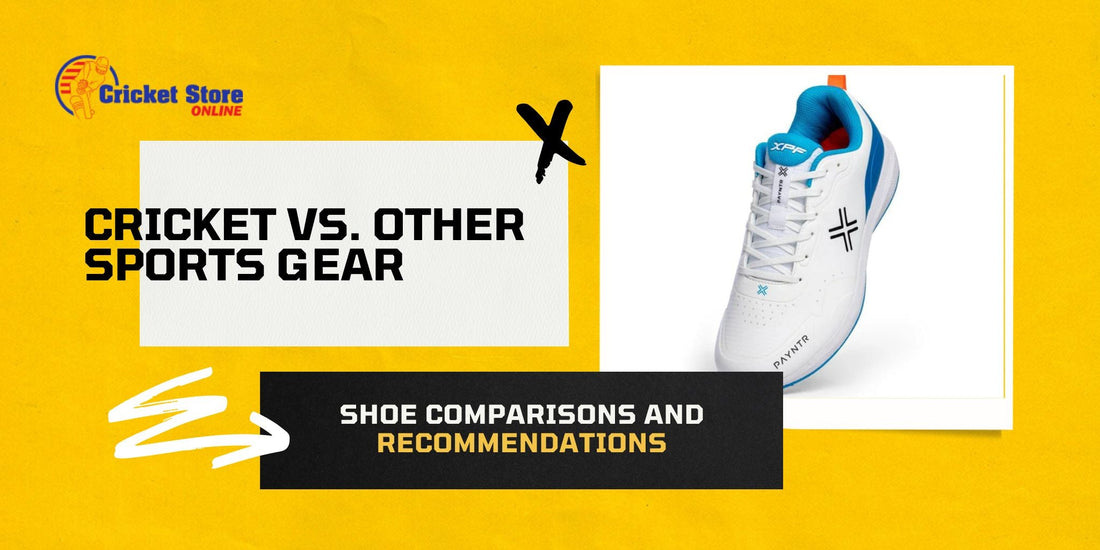Cricket vs. Other Sports Gear: Shoe Comparisons and Recommendations
When it comes to athletic footwear, many athletes wonder whether they can cross-train with equipment from different sports. Cricket players often ask if they can use soccer cleats, tennis shoes, or other sports gear instead of investing in cricket-specific footwear. This comprehensive guide examines cricket vs. other sports gear, focusing on shoe comparisons to help you make informed decisions about your athletic footwear investments. Understanding these differences is crucial for performance, safety, and getting the best value from your sports equipment purchases.
Table of Contents
- Understanding Cricket Shoe Design vs. Other Sports Footwear
- Cricket vs. Soccer Cleats: Key Differences and Similarities
- Cricket Shoes vs. Tennis Shoes: Court vs. Field Performance
- Cricket vs. Baseball Cleats: Diamond vs. Pitch Comparisons
- Cricket Footwear vs. Rugby Boots: Contact Sport Gear Analysis
- When to Use Cricket Shoes vs. Other Sports Gear
- Multi-Sport Athletes: Shoe Recommendations and Alternatives
- Cost-Effective Cricket vs. Other Sports Gear Shopping Guide
Understanding Cricket Shoe Design vs. Other Sports Footwear
Cricket shoes feature unique design elements that distinguish them from other sports gear. The most notable difference lies in their spike configuration, which typically includes 6-12 metal or rubber spikes strategically placed across the sole. This pattern provides optimal traction for cricket's diverse movements - from quick sprints between wickets to sudden directional changes while fielding.
Unique Features of Cricket Shoe Construction
Cricket footwear incorporates several specialized features that set it apart from general athletic shoes. The toe protection design includes reinforced materials at the front of the shoe, essential for batsmen who drag their feet during shots. This reinforcement prevents premature wear and maintains structural integrity throughout extended play sessions.
The ankle support system in cricket shoes balances stability with mobility, allowing for the multi-directional movements required in cricket. Unlike basketball shoes that prioritize high ankle support or running shoes that focus on forward motion, cricket gear must accommodate lateral movements, quick pivots, and sustained running periods.
How Cricket Gear Differs from General Athletic Footwear
Material selection in cricket vs. other sports gear reflects the specific demands of each sport. Cricket shoes often utilize premium leather uppers for durability and weather resistance, while incorporating synthetic materials for breathability. The weight distribution in cricket footwear typically centers around the midfoot, supporting both batting stances and running efficiency.
| Feature | Cricket Shoes | Running Shoes | Soccer Cleats | Tennis Shoes |
|---|---|---|---|---|
| Spike Pattern | 6–12 spikes, full sole | No spikes | Bladed cleats | Court-specific treads |
| Toe Protection | Reinforced leather/synthetic | Minimal | Ball contact areas | Court abrasion resistance |
| Ankle Support | Medium flexibility | Low support | Variable by position | Lateral support focus |
| Weight | 350–450g | 250–350g | 200–300g | 350–450g |
Cricket vs. Soccer Cleats: Key Differences and Similarities
The comparison between cricket and soccer cleats reveals both surprising similarities and crucial differences. Both sports require quick directional changes and sustained running, but their footwear addresses different performance priorities.
Spike Configuration Comparison
Cricket's full-spike configuration contrasts sharply with soccer's bladed cleat system. Cricket spikes penetrate the ground uniformly across the sole, providing stable traction during batting, bowling, and fielding. Soccer cleats concentrate traction at specific pressure points, optimizing for ball control and rapid acceleration.
The ground penetration depth varies significantly between these sports gear options. Cricket spikes typically extend 12-15mm from the sole, allowing deep ground engagement on soft pitches. Soccer cleats range from 6-13mm, with variations based on ground conditions and playing surface requirements.
When Soccer Cleats Might Work for Cricket
Recreational cricket players sometimes successfully use soccer cleats as cricket alternatives, particularly on firm, dry pitches where deep spike penetration isn't essential. However, this substitution comes with performance compromises and safety considerations that serious players should carefully evaluate.
Cricket Shoes vs. Tennis Shoes: Court vs. Field Performance
Tennis shoes and cricket footwear address fundamentally different movement patterns and surface requirements. Tennis court shoes excel at lateral stability and quick direction changes on hard surfaces, while cricket gear optimizes for varied terrain and extended play periods.
Surface-Specific Design Elements
The sole construction differs dramatically between tennis and cricket gear. Tennis shoes feature non-marking rubber soles with herringbone or modified herringbone patterns designed for court traction without surface damage. Cricket shoes incorporate spike systems that engage with natural grass surfaces, providing superior grip during wet conditions.
Cushioning systems also vary significantly. Tennis shoes typically feature maximum heel cushioning to absorb the impact of constant stopping and starting on hard courts. Cricket footwear balances cushioning with ground feel, allowing players to sense pitch conditions through their feet - crucial for bowlers and batsmen reading surface variations. Learn whether are running shoes good for cricket and what experts recommend for optimal performance.
Cricket vs. Baseball Cleats: Diamond vs. Pitch Comparisons
Baseball and cricket cleats share more similarities than differences, making them potentially cross-compatible in certain situations. Both sports involve running, sliding, and quick directional changes, resulting in comparable footwear requirements.
Cleat Pattern and Traction Analysis
Baseball cleats typically feature 9-12 cleats arranged to optimize base running and fielding movements. The heel cleat placement in baseball gear differs from cricket shoes, reflecting baseball's emphasis on explosive starts from stationary positions. Cricket's more uniform spike distribution supports the sport's continuous movement patterns.
Metal spike options exist in both sports, though regulations vary by league and competition level. Professional cricket often permits metal spikes for enhanced traction, while recreational leagues may restrict players to rubber alternatives for safety reasons.
Cross-Sport Compatibility Assessment
Baseball cleats can serve as acceptable cricket alternatives for recreational players, particularly those playing on well-maintained grass fields. The protection features and spike patterns provide adequate performance for casual cricket, though dedicated cricket shoes offer superior comfort and specialized features for serious players.
Cricket Footwear vs. Rugby Boots: Contact Sport Gear Analysis
Rugby boots and cricket shoes address different sport-specific challenges while sharing certain design philosophies. Rugby footwear prioritizes protection and stability for contact situations, while cricket gear balances protection with agility and comfort for extended play periods.
Spike Design for Different Playing Surfaces
Rugby boots feature 8-10 conical or bladed studs designed to provide traction during scrums, rucks, and tackles. The stud configuration varies based on playing position and ground conditions, with forwards typically using longer studs for better grip during set pieces.
Cricket spike systems offer more consistent traction patterns across the sole, reflecting the sport's emphasis on running and multi-directional movement rather than static power situations. This difference makes rugby boots less suitable for cricket's specific movement requirements.
When to Use Cricket Shoes vs. Other Sports Gear
Choosing between cricket-specific footwear and alternatives depends on several factors including playing level, surface conditions, and individual performance priorities. Professional and competitive players typically require dedicated cricket shoes for optimal performance and injury prevention.
Playing Level Considerations
Recreational cricket players often successfully use alternative sports gear, particularly on firm, dry surfaces where specialized traction isn't critical. However, as playing intensity increases, the performance benefits of cricket-specific footwear become more apparent.
Junior players present unique considerations in the cricket vs. other sports gear debate. Growing feet and budget constraints often favor versatile footwear options, though safety should never be compromised for cost savings.
Surface and Weather Conditions
Wet conditions dramatically favor cricket-specific spikes over alternative footwear. The deep penetration and strategic spike placement in cricket shoes provide superior traction on soft, slippery surfaces where other sports gear may prove inadequate or dangerous.
Hard, dry pitches offer more flexibility for alternative footwear choices. Tennis shoes or cross-trainers may provide adequate traction while offering superior comfort for extended play sessions in hot conditions.
Multi-Sport Athletes: Shoe Recommendations and Alternatives
Athletes participating in multiple sports face unique challenges when selecting appropriate footwear. Cost-effective solutions often involve identifying versatile options that perform adequately across different activities while maintaining safety standards.
Versatile Footwear Options for Multiple Sports
Cross-training shoes represent a compromise solution for multi-sport athletes, offering reasonable performance across various activities without excelling in any specific sport. These shoes typically feature moderate cushioning, basic lateral support, and durable construction suitable for diverse athletic activities.
Removable spike systems offer another innovative solution for athletes transitioning between sports seasonally. These systems allow the same shoe upper to accommodate different sole configurations, maximizing equipment utility while maintaining sport-specific performance characteristics. See our analysis on can golf shoes be used for cricket and how they compare to traditional cricket footwear.
Performance Impact of Using Non-Cricket Specific Gear
Using alternative sports gear for cricket typically results in performance compromises rather than complete inadequacy. Players may experience reduced traction during quick movements, less comfort during extended play, or increased fatigue due to inappropriate weight distribution.
Injury risk assessment becomes crucial when considering non-cricket footwear. Inadequate ankle support, poor traction, or inappropriate cushioning can increase the likelihood of slips, falls, or overuse injuries during cricket activities.
Cost-Effective Cricket vs. Other Sports Gear Shopping Guide
Budget-conscious athletes often seek value-oriented solutions that balance performance with affordability. Understanding the cost implications of different footwear choices helps players make informed decisions based on their specific needs and circumstances.
Price Comparison Across Sports Equipment
Cricket shoes typically range from $50-300, depending on brand, materials, and features. This pricing falls within the middle range compared to other sports gear, with tennis shoes ($40-250) and soccer cleats ($30-400) offering similar price distributions.
Premium cricket footwear often provides better value than comparable alternatives due to sport-specific features and construction quality. While initial costs may be higher, the specialized design typically results in improved durability and performance for cricket-specific applications.
Making Smart Purchase Decisions
Quality indicators remain consistent across different sports gear categories. Look for reinforced stitching, premium materials, established brand reputation, and appropriate safety certifications when evaluating footwear options.
Consider the cost per hour of use when comparing cricket vs. other sports gear. Dedicated cricket shoes may justify higher initial costs through improved comfort, performance, and durability for regular players, while occasional participants might find adequate performance in less expensive alternatives.
Conclusion
The cricket vs. other sports gear comparison reveals that while alternatives can work in certain situations, cricket-specific footwear offers distinct advantages for serious players. Soccer cleats, tennis shoes, and other athletic footwear may serve as temporary solutions or work adequately for recreational play, but they cannot fully replicate the specialized features of dedicated cricket shoes.
When choosing between cricket shoes and alternatives, consider your playing level, surface conditions, and performance priorities. Competitive players benefit most from cricket-specific gear, while recreational athletes have more flexibility in their footwear choices. Remember that safety should never be compromised for cost savings, and proper footwear plays a crucial role in injury prevention and optimal performance on the cricket field.
Whether you choose dedicated cricket footwear or explore alternatives, understanding these differences empowers you to make informed decisions that enhance your cricket experience while protecting your investment in sports equipment.


